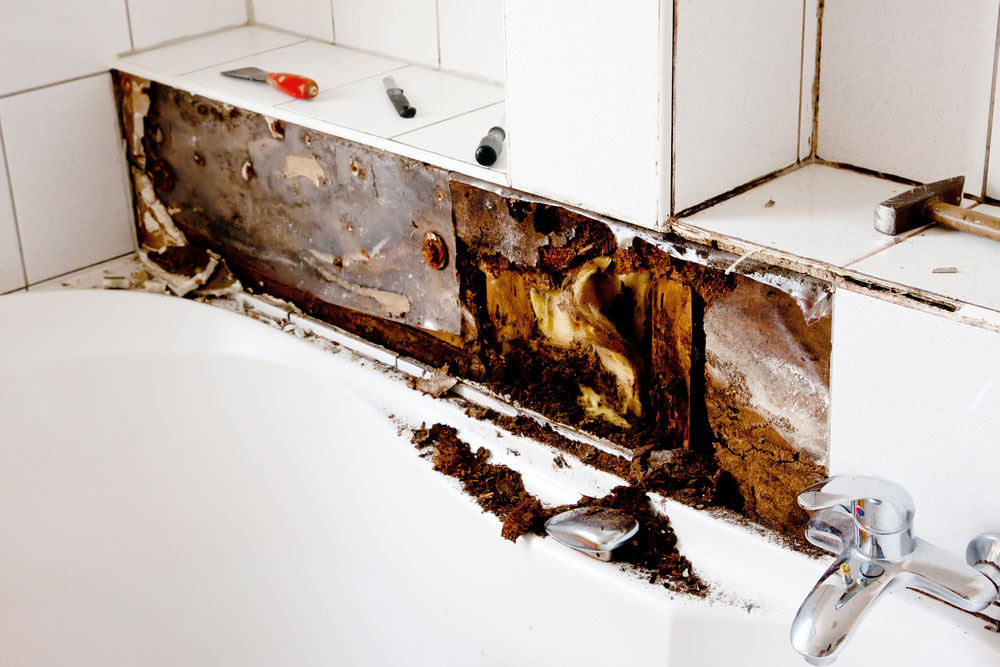Have you been hunting for advise concerning How to Prevent Bathroom Water Damage?

The washroom is very prone for moist accumulation and also possible water damages due to the frequent use water in it. This post uses easy inspection strategies to assist discovering water damage threats.
The regular use of water in the bathroom makes it exceptionally prone for moist buildup as well as prospective water damage. By checking it on a regular basis, you can decrease water relevant problems.
The following collection of evaluations is easy to execute as well as should be done as soon as in every three months in order to keep your shower room in good shape and also to avoid potential water problems triggered by the bath tub, the shower, pipe joints and plumbing, sinks, closets, and the commode
Do not overlook executing these inspections and also be extensive while performing them. Bear in mind that these easy examinations can save you a great deal of money by giving early signs for water damage
Sinks and also Cabinets
Sinks as well as closets are subjected to dampness and moisture daily and also are frequently ignored. Inspect on a regular basis under the sink and on the counter top over it. Repair any type of drip in the trap as it may recommend drain issues. Look around the sink, sluggish draining pipelines may suggest an obstructed drain. Change sink seals if they are fractured or loose.
Bath tub and Shower
The shower as well as bath tub require special focus and maintenance. Examine the tiles and change if fractured. Ensure that there is no missing out on cement between the ceramic tiles. Evaluate and replace split caulking at joints where the wall surfaces meet the floor or the tub. Obstructed drains and pipelines troubles will avoid the tub from drying out and also may indicate severe troubles beneath the bathtub. Speak with an expert quickly to prevent structural damage. Focus on stainings or soft locations around the bath tub walls as they may indicate an interior leakage.
Plumbing
Signs for water damages are tough to identify since many pipes are set up inside the wall surfaces.
Pay unique focus to floor covering and also wall surfaces moisture and stains as they may indicate an unnoticeable plumbing issue. Inspect wetness levels in adjacent spaces also.
The Bathroom
The bathroom is a prone water joint. Inspect the water lines as well as look for leakages around the bathroom seat, in the pipe, as well as under the water storage tank. If you find any type of indications of wetness on the floor around the bathroom, check for leaks in the toilet rim and tank seals.
Be aware that hanging commode dish antiperspirants boosts the possibilities for blockages.
Water Damage Signs In The Bathroom To Avoid Cleanup
Musty smell
This is one of the easiest signs to catch because musty smells are so odorous. The damp, earthy, moldy smell should be a big red flag. The smell will develop when moisture gets trapped in surfaces, and begins to facilitate mold growth. Leaking pipes under cabinets, inside walls, and behind shower fixtures will cause moisture to stay trapped and not dry, which will lead to mold growth and spread. As soon as you notice any musty smells in your bathroom, have it checked for hidden water damage and cleanup signs.
Visible mold
If the smell isn’t there to give it away, sometimes you will actually see mold growth. Finding mold in your bathroom is a serious problem, because mold is very harmful to your health. By the time mold growth is visible, it also means that water damage has already occurred and been present for some time. The only way the mold problem can be resolved is to find the source of the moisture and get it stopped. To safely and adequately remove mold, you need to have professionals handle the remediation. Do not waste any time in getting mold problems addressed, fixed, and sanitized so that you can protect you and your family from the many respiratory symptoms caused by mold exposure.
Damaged floors
Bathroom floors should be able to withstand some exposure to water while still remaining in good condition. However, when excess exposure or water leaks occur, they will begin to damage even the most water-resistant flooring. If you notice any cracking, bubbling, staining, or warping on your bathroom floors, there is probably a water leak somewhere causing the distortion. If you notice areas of the floor have become softer, or even have a spongy feeling, there is probably damage to the subfloor. Subflooring is typically made up of plywood. When plywood is exposed to water or moisture, it will absorb it. Once it has become saturated, the weight of the excess water will cause the wood to swell and soften. Check the floors in your bathroom frequently to catch any of these sings before they lead to damaged subflooring.
Changes on walls
When water leaks behind walls, it will cause changes in the drywall. Peeling plaster, blistering paint, and soggy wallpaper are all good indicators that excess water is building up behind the wall. Water leaking behind drywall will cause it to swell and be soft to the tough. If you start to notice gaps along the trim of your walls, or where tile meets the wall, it could also be a strong indicator that there is a leak behind the wall. Any changes, distortion, or damage on the walls should be evaluated as soon as you notice it to prevent further water damage and cleanup.

I hope you enjoyed reading our piece on Preventing Water Damage in the Bathroom. Thanks for spending some time to read through our article post. Sharing is good. Helping others is fun. I appreciate reading our article about How to Prevent Bathroom Water Damage.
Get Offer
Comments on “How to Stop Water Damage in Your Bathroom”